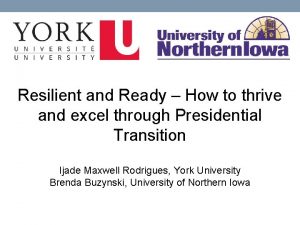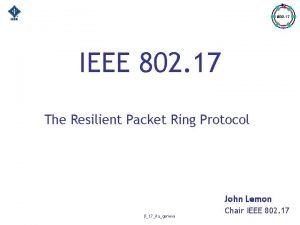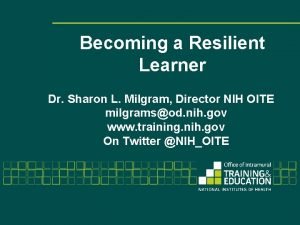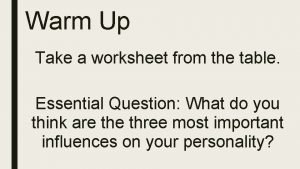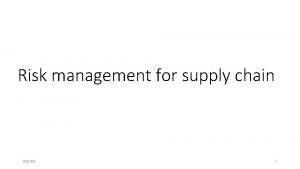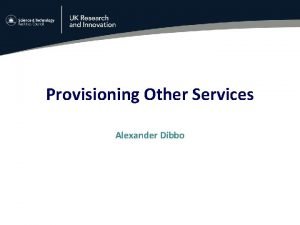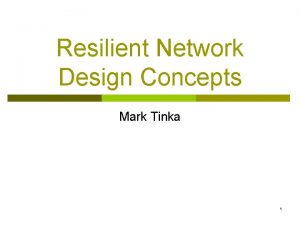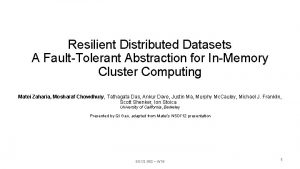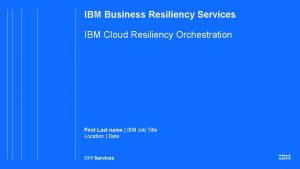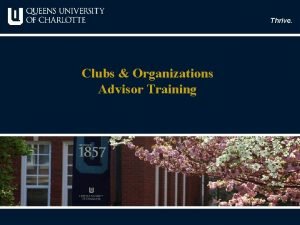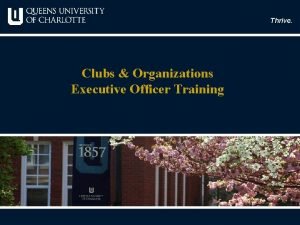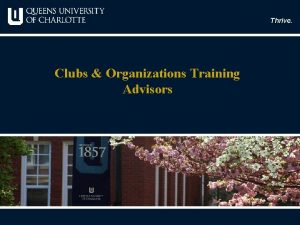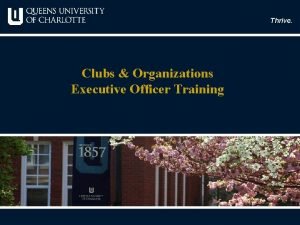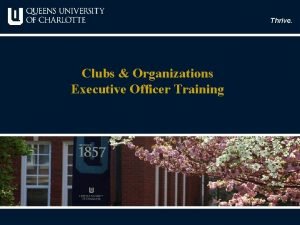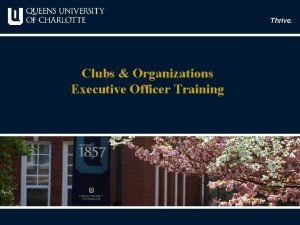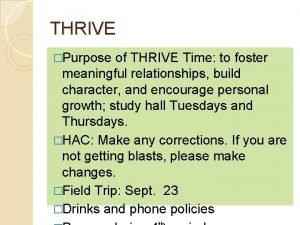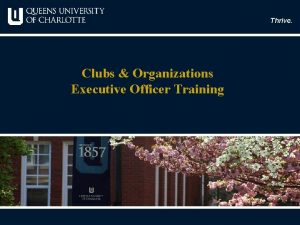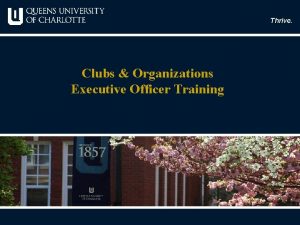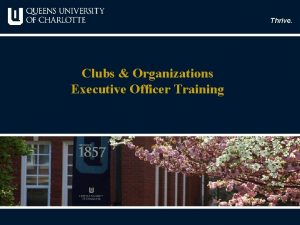Resilient and Ready How to thrive and excel


















- Slides: 18

Resilient and Ready – How to thrive and excel through Presidential Transition Ijade Maxwell Rodrigues, York University Brenda Buzynski, University of Northern Iowa

WHAT ARE PRESIDENTIAL TRANSITIONS… “Transitions are critical moments in the lives of organizations and individuals. . . one needs to understand what transitions mean, not only from one‘s own perspective, but also from the viewpoint of others. ” Thomas N. Gilmore (1988)

CHANGE AND TRANSITION… “Change is not the same as transition. Change is situational…while transition is the psychological process people go through to come to terms with the new situation. ” William Bridges (1980) The process of transitioning is the way in which the president and others respond to these changes.

WHY MANAGING A TRANSITION IS IMPORTANT… • Change and transition affect both individuals and institutions so it is critical to strategically manage a presidential succession and transition. • Transitions present opportunities. • Transitions are imperfect progress.

ROLE OF THE PRESIDENTIAL ASSISTANT “A carefully planned and executed entry becomes the new president’s first act of leadership” (Judith Block) • • • Get Prepared. Reach out. Update Documents. Plan and Implement. Recognition of the past. Make an impression.

ROLE OF THE PRESIDENTIAL ASSISTANT Plan for five conversations to build your relationship with the President-Designate: • Understand how he/she sees the situation at the University. • Understand the President’s expectations • Understand his/her working style • Discuss what resources are critical to move his/her priorities forward • Discuss how your role will contribute to your professional development

TRANSITION STAGES I. Ending a university chapter, celebrating a legacy II. Neutral Clarity of start date for new president, ensure celebration and respect of sitting president III. New Beginning Ground rules for the transition, opportunity to launch new excitement Moore, J. W. , & Burrows, J. M. , (2001). Presidential Succession and Transition: Beginning, Ending, and Beginning Again. American Association of State Colleges and Universities (AASCU), Washington, DC.

I. ENDING • Transitions begin with endings – the process of accepting the inevitability of the impending change and learning to let go of the past. • Exiting president: – The university is ending a chapter – Celebrating a legacy (depends on the situation) – One reason organizational change fails is that no one thought about endings or planned to manage their impact on people. Presidents are owed a dignified ending to the presidency. – How an organization handles the ending of one president is an indicator of how they will handle the incoming president. – The ending of a presidency reflects on the university and on the president’s office.

I. ENDING Example documents for Exiting a President. 1. Ending Checklist 2. Proclamation 3. Highlights (one-page) 4. Highlights (comprehensive)

II. NEUTRAL • Managing the neutral zone/overlap between a named new president and a sitting president. • Coping with the ambiguities associated with the end of one, and the newness of moving between a previous president and a new president. • Clarity of start date for new president, ensure celebration and respect of sitting president

II. NEUTRAL • For new president, designate a transition coordinator/leader to manage communications and orientation activities. • Communicate to the campus community and other constituencies the “ground rules” pertaining to the management of the transition. (Once new president is named, the flurry of emails, correspondence begins for the new president. ) • Coordinate campus visits for the new president. Ensure new president gets to know the campus constituents (internal) before embarking on meeting the external constituents. • Discuss transition planning with the new president.

III. NEW BEGINNING • Before you can begin something new, you must end what used to be. • New beginnings involve letting go of the past, redefining who you are, adjusting to new roles, and accepting a new reality. • Beginnings involve new understanding, new attitudes, new values, and new identities. • Avoid the twin errors of moving too quickly and too slowly. • Determine ground rules for the transition • This is an opportune time to launch new excitement on-campus.

TRANSITION PLANNING BEST PRACTICES • Steering Committee to guide transition • Create a Learning Network for the President-designate • Use Presidential transition to raise institutional awareness and priorities of the university. • Use a variety of channels to welcome, educate and orient the Presidentdesignate. • Orientation Activities with a variety of audiences • Seek input from the university community on orientation activities for the President-designate

III. NEW BEGINNING Example documents for Entering President. 1. 2. 3. 4. 5. 6. 7. Communicating with Incoming President Operational To-Do’s once President is named First Questions for Presidential Transition Committee-Agenda Presidential Introduction Committee Potential Orientation Process Relationship Building – Brief list

CASE STUDY – UNIVERSITY OF NORTHERN IOWA UNI – Midwestern Public Comprehensive University, enrollment 13, 200 August, 2012 President announced retirement no later than July 1, 2013 Sept. , 2012 Board of Regents, State of Iowa initiated search – 22 member search committee and utilized search firm – Parker & Associates. Search: – Mid-Jan. – interviewed 10 candidates – Minneapolis airport – At announcement time – only 3 names released – 3 to campus late Jan. /early Feb. – then 1 withdrew – 2 remaining – Feb. 7 am – 2 interviewed with the Board – Feb. 7 3: 30 pm – Board announced their selection (media present) – Feb. 7 4: 30 -6: 30 pm reception held immediately for the named president

CASE STUDY – UNIVERSITY OF NORTHERN IOWA Visit #1: Feb. 28 -Mar. 1 – Incoming President – trip to campus – Meet with faculty leaders, direct reports, have a campus-wide “welcome reception”, meet with sitting president, take care of house logistics etc. Visit #2: Mar. 19 -21 (spring break on-campus) – potential visit – to Des Moines – visit legislators and to campus to visit with academic leadership Visit #3: Early - April – potential 3 rd visit to campus – visit with faculty, staff and student leaders etc. Late May – relocate to Pres. house June 1 – start date

THANK YOU! GOOD LUCK WITH YOUR PRESIDENTIAL TRANSITION Ijade Maxwell Rodrigues York University Brenda Buzynski University of Northern Iowa

REFERENCES ACE. (2008). The Presidency: The American Council on Education’s magazine for higher Education Leaders. Special Supplement. Winter. Washington, DC: American Council on Education. ACE. (2008). King, J. , & Gomez, G. , On the pathway to the presidency: Characteristics of higher education’s senior leadership. The American college president: 2007 edition. Washington, DC: American Council on Education. Bridges, W. , (2003). Managing Transitions: Making the Most of Change. 2 nd Edition. Da Capo Press. ISBN: 0738208248 Fethke, G. , & Policano, A. , (2012). The Precarious Profession of University Presidency. The Chronicle of Higher Education, July 23. Kiley, K. , (2012). A Pre-Presidential Initiative. Inside Higher Ed. March 5. Martin, J. , & Samels, J. E. , (2004). Presidential Transition In Higher Education. Baltimore: Johns Hopkins University Press. Martin, J. , & Samels, J. E. , (2005). Closing Remarks: The End of the Beginning: Recognizing successful presidential transitions. Council for Advancement and Support of Education (CASE). Moore, J. W. , & Burrows, J. M. , (2001). Presidential Succession and Transition: Beginning, Ending, and Beginning Again. American Association of State Colleges and Universities (AASCU), Washington, DC.
 Thrive and excel
Thrive and excel Stay ready to keep from getting ready
Stay ready to keep from getting ready Marginal and attached gingiva
Marginal and attached gingiva Token ring and resilient packet ring
Token ring and resilient packet ring Rssh health
Rssh health Sharon milgram nih
Sharon milgram nih Rhmd: evasion-resilient hardware malware detectors
Rhmd: evasion-resilient hardware malware detectors Resiliency
Resiliency Pnt gnss
Pnt gnss Resilient attitude
Resilient attitude It came on great oiled resilient striding legs
It came on great oiled resilient striding legs How can you be resilient
How can you be resilient How can more resilient
How can more resilient How can more resilient
How can more resilient How can be more resilient
How can be more resilient Torpedo traffic generator
Torpedo traffic generator Network design concepts
Network design concepts Resilient distributed datasets
Resilient distributed datasets Ibm cloud resiliency
Ibm cloud resiliency
